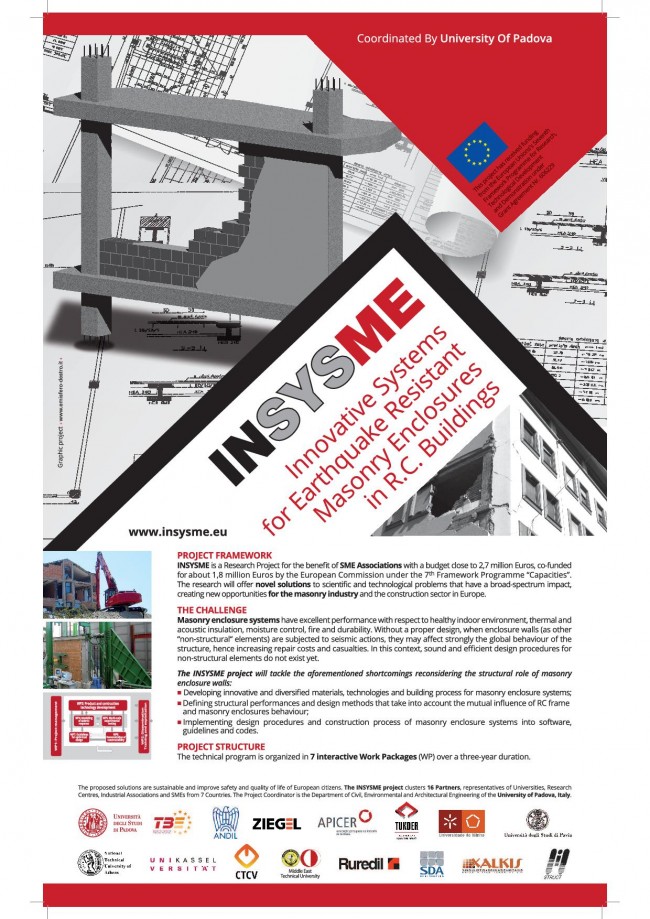Research activity
INSYSME – HI STRUCT presentation
INNOVATIVE SYSTEMS FOR EARTHQUAKE RESISTANT MASONRY ENCLOSURES IN REINFORCED CONCRETE BUILDINGS
The use of masonry infill walls and, to a certain extent, veneer walls, especially in reinforced concrete (RC) framed structures, is widespread in many countries. This practice derives from the natural evolution of the traditional building technique, which was based on masonry walls. The exceptionally rapid growth in the use of RC elements for creating the bearing structure, transformed the latter into a “wire frame” of negligible volume, mass and stiffness, when compared to traditional masonry walls.
With reference to structural problems, it has to be underlined that they have only recently started calling additional attention, and still no suitable solutions, acceptable under all possible points of view (compliance with code required performance, safety, economy, aesthetics, durability, adequacy of design procedures, etc.), have been investigated and proposed. This fact is particularly pronounced when the so-called non-structural elements are subjected to actions that force them to behave structurally, as in the case of earthquakes, strong winds, etc
Throughout the years, earthquakes influenced the way in which buildings react to the ground motion. Many injuries and deaths occurred as a result of buildings collapse or the collapse of some non-structural elements of a building, such as masonry infill walls. Guidelines estimate the structural interventions for commercial buildings to be approximately 20-25% of the original construction cost, while the other elements account for the remaining 75-80%. Also, statistical studies carried out by insurance companies refer to similar costs for repair and reconstruction of non-structural elements after earthquakes.
In this context, most design codes recognized that also non-structural elements need to be designed for earthquake actions. The European structural design codes of reinforced concrete and masonry buildings do not specify any details regarding the performance requirements or compliance criteria for the safe use of masonry enclosures, nor for the behaviour at serviceability and ultimate limit states. This absence of clear performance requirements, design methods and practical measures can hinder in the long term the further development of masonry construction systems for enclosure walls and, even worst, could turn to be ineffective, causing greater damage to the industrial sector.
Enclosure “specialization” for adequate earthquake resistance is the core of the project and will consist in defining integrated and innovative systems, such as to:
- optimize (maximize) the local structural performance, by limiting damage under the most frequent (and less intense) earthquakes and minimizing the probability of detachment and out-of-plane collapse under the effects of the most intense, i.e. the “design”, earthquakes (for verification at the ultimate limit state);
- minimize the negative effects that inadequate design and construction of enclosures walls cause on the global structural behaviour of the RC framed structure under the effect of the design earthquake, i.e. at the ultimate limit state;
- enhance and exploit the non-structural performance of the infill/veneer walls, i.e., from one side, all the properties related to environmental, energy saving and comfort aspects, but also, on the other side, those related to the capacity of limiting damage under serviceability limit states, thanks to the use of innovative smart solutions.
The contribution to the technological progress of this project consists in a given set of innovations, such as:
- Advanced innovative building technologies for enclosures (with respect to units, reinforcement, fasteners/connectors, mortar, and their assemblages), diversified according to seismic risk levels, regional construction traditions and environmental conditions, satisfying all requirements of insulation, indoor comfort, durability, sustainability, as well as serviceability and ultimate limit states;
- New and/or advanced testing procedures for the experimental assessment of the combined in-plane out-of-plane behaviour of infills and validation/qualification of the developed solutions;
- Definition of the interaction between frame and infill, in terms of seismic input on the infill for various frame conditions (type, elastic or inelastic behaviour, etc.), and seismic risk level;
- Original and complete sets of guidelines (i) for the design of RC structures with enclosure walls, (ii) for the design, detailing and construction of enclosure walls, including assessment of in-plane strength and of out-of-plane strength for varying level of in-plane damage, as well as the definition of relevant limit states for different infill/veneer typologies, and (iii) for the verification of ties, fasteners/connectors and other components in special systems;
- Transfer of guidelines for design, detailing and construction into standards;
- Advanced practical tools for the analysis and design of enclosure walls (design charts, software package etc.);



